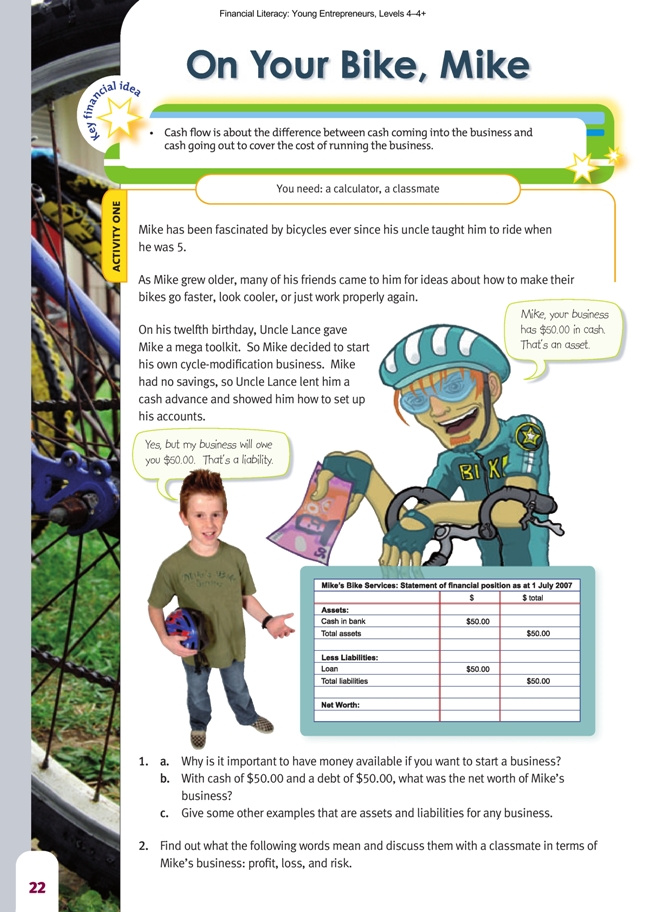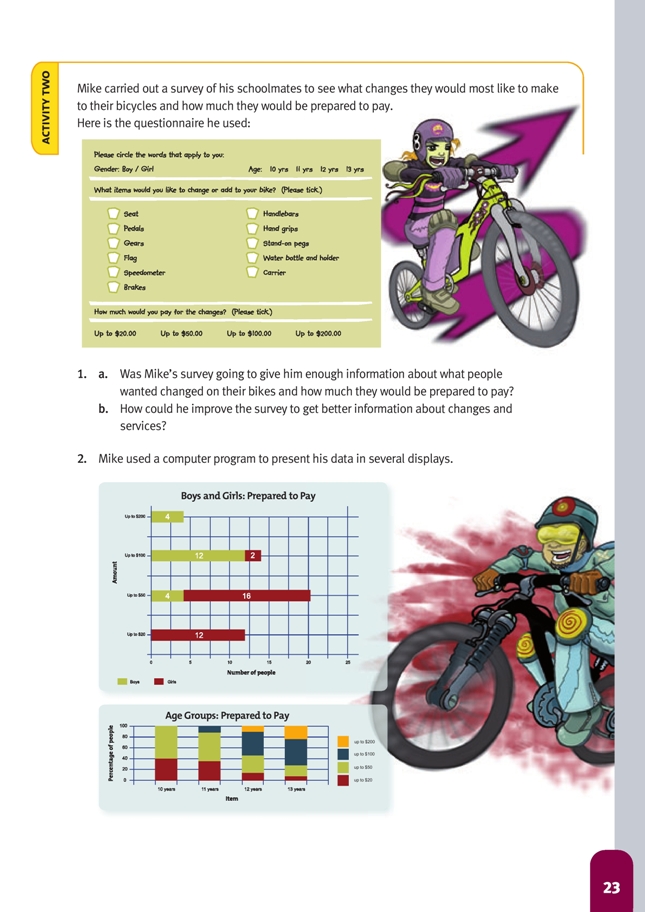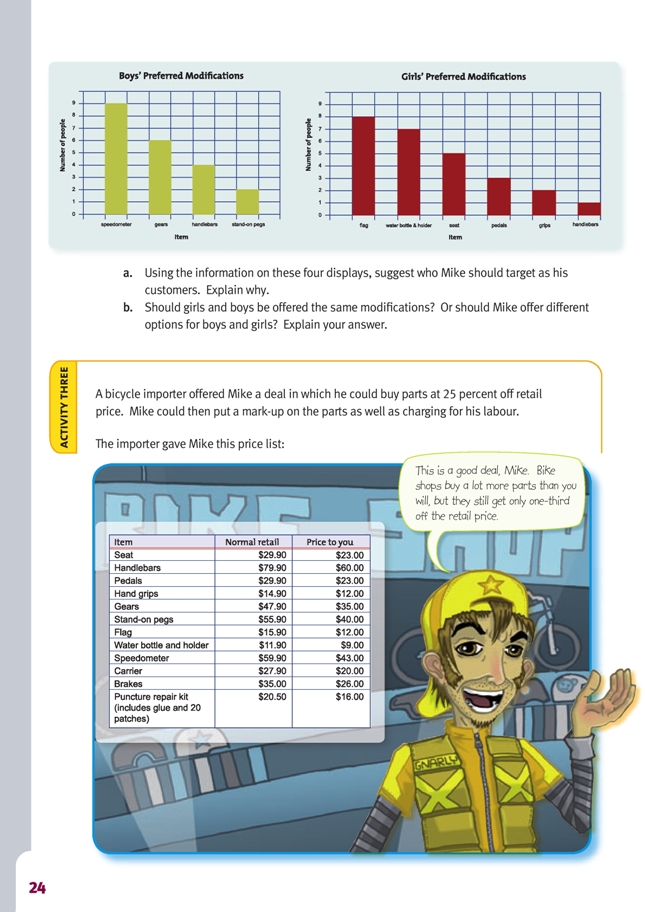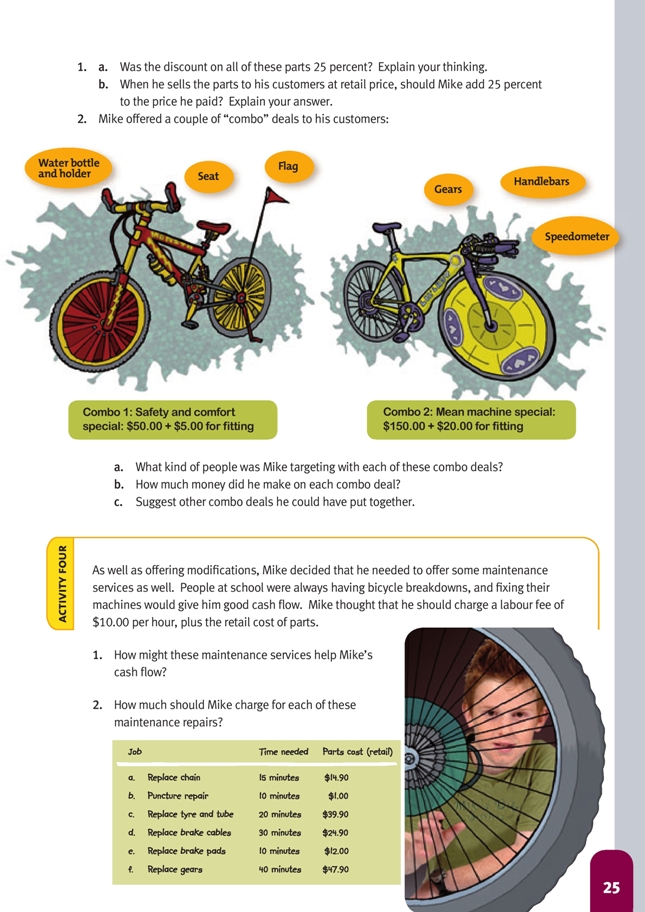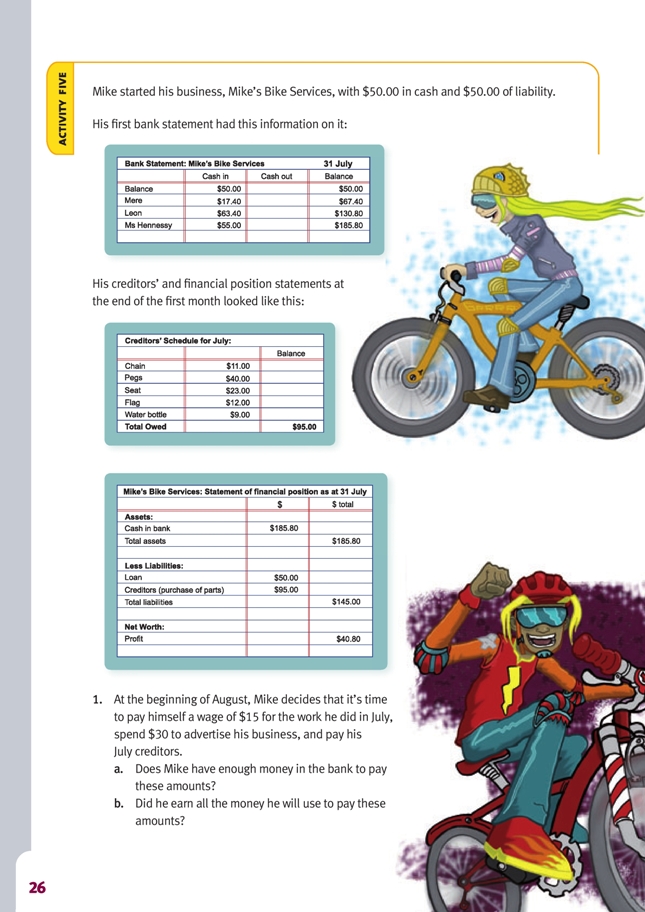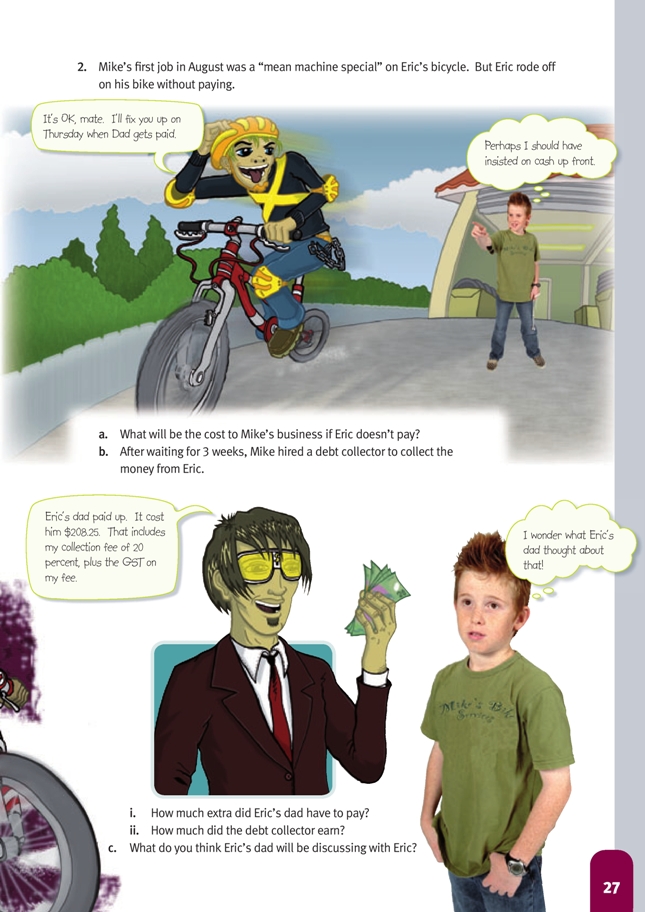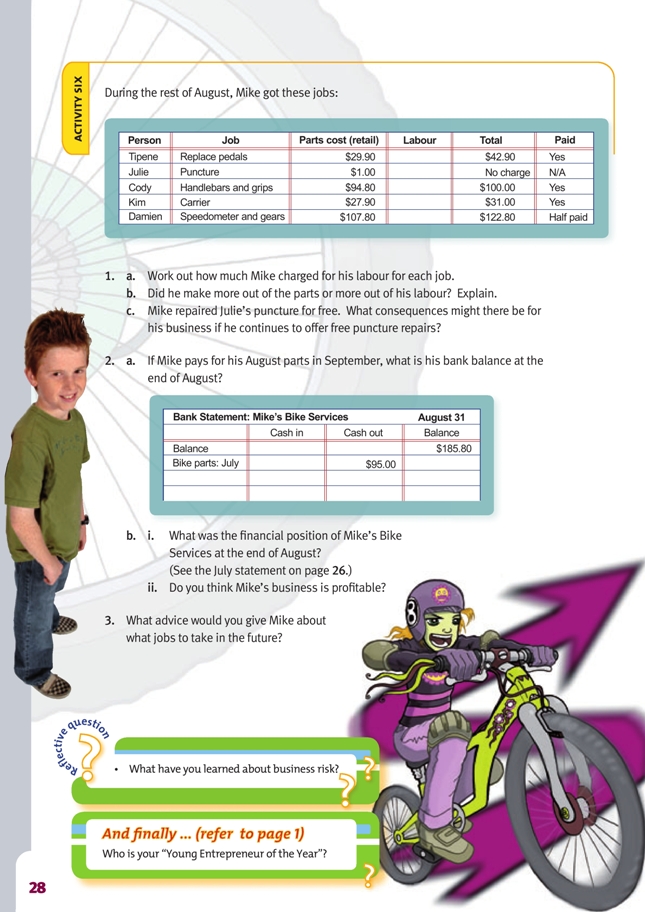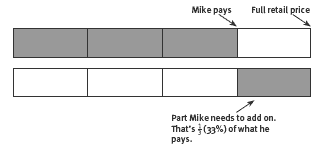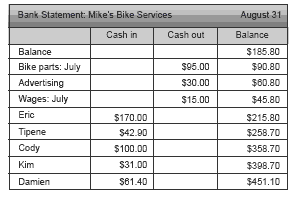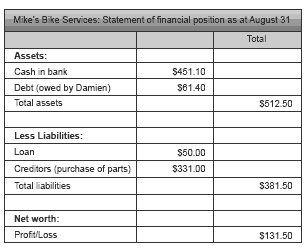This is a level 4 number, algebra, and statistics activity from the Figure It Out series. It relates to Stage 7 of the Number Framework.
A PDF of the student activity is included.
Click on the image to enlarge it. Click again to close. Download PDF (2790 KB)
analyse survey questions
interpret information from graphs
find percentages of numbers
use addition and subtraction to solve money problems
FIO, Level 4-4+,Financial Literacy: Young Entrepreneurs, On your Bike Mike, pages 22-28
classmate
Financial language
Cash advance, assets, liabilities, net worth, profit, loss, risk, mark-up, cash flow, creditors’ schedule, financial position, wage, debt, balance.
Financial understanding
The series of activities based on Mike’s business explores the idea of cash flow and assets and liabilities and the net worth of a business. Businesses need accessible cash to pay expenses. Some businesses have high cash flow, which means a large amount of money is paid to the business in a short time. This is usually matched by a large volume of money paid out by the business for the purchase of goods and services it needs for production. Supermarkets and fast food outlets are good examples of businesses with high cash flow.
Mike experiences having an unpaid account that puts his business at risk. Identifying, assessing, and managing risks is an essential attribute to have if people and their businesses are to succeed in the longer term.
Activity One
Financial understanding
Other businesses often have long periods of time between earning sales revenue. These businesses need to manage their cash flow so that they have money available to pay costs like wages and rent. Cash flow might be managed by having a good amount of capital to set up the business or by borrowing money from a bank. Aeroplane/car manufacturers, caterers, and real estate agencies are examples of businesses that have irregular cash flow, relying on one-off big sales for their income.
Liabilities are any debt to a business. The loan from Mike’s uncle is an example of a liability, but things such as the outstanding payments for hire purchase or unpaid rents are other types of liabilities. Assets are things belonging to the business that are of value. Assets may take the form of cash, items of equipment, buildings, vehicles, and in this scenario, Mike’s toolkit.
A business needs to manage cash flow, its ability to pay bills, and the balance between its assets and liabilities. With a debt of $50.00 and an asset of $50.00 in cash, Mike has a balance of zero because paying off the debt cancels the liability, reducing his assets to nothing.
From previous activities in this book, students should know the meaning of profit (the money left over from selling goods or services once the costs of production are taken off). A loss is the opposite of a profit, where the costs of production are greater than the revenues from sales. Obviously, firms that make regular profits tend to have a positive balance between assets and liabilities, whereas those that make regular
losses may have a negative balance. Sustainable and financially responsible businesses make a profit.
All businesses deal with risks. Risks are dangers to the profitable running of a business. Risks are many and varied, from sickness of workers, to bad debts, to unavailability of raw materials, to changes to financial costs like interest and international exchange rates.
Social Sciences Links
Achievement objective:
• Understand how people pass on and sustain culture and heritage for different reasons and that this has consequences for people (Social Studies, level 4)
Have the students discuss how Uncle Lance has sustained and passed on part of Mike’s heritage. (The answer could be that he has taught him to ride a bike [passed on part of his heritage] and continues to sustain this interest in bikes [through the gift of tools and lending him start-up money].)
Activity Two
Financial understanding / Mathematics and statistics
This activity considers the importance of using surveys to find out the demand for products or services prior to producing them. This is an important tool for managing risk through identifying potentially poor demand and then tailoring the product to the wants and needs of buyers.
Mike’s survey is simple and targets the demographics of his customers (that is, gender, age) and specific item preference. Linking these two things allows Mike to develop packages that meet the general needs of customers. Mike may have missed out on potential sales through failing to personalise the survey. Asking people for their name and allowing them an “other” option under the item preferences may have given him data on other useful products to offer.
Using either a computer spreadsheet or database to enter the survey results would allow Mike to look for relationships in the multivariate data. Multivariate means that there are several variables, that is, gender, age, item preference, payment maximum. The graphs shown are designed to make the relationships more explicit than a tabular format rather than to display relationships already identified.
The first graph shows a trend that boys are prepared to spend more money on their bicycle modifications than girls. In this case, the spatial features of the graph are more important than the numerical information. Each bar represents a proportion of responses from a given range of spending. It is these proportions that are significant.
The second graph also uses a proportional representation for each age group. Encourage your students to look for the main patterns in the data rather than to read the percentages for individual bars and to consider what these patterns mean for Mike’s business. In general, older students are willing to spend more on modifying their bicycles than younger students. So Mike can opt to go for a large number of
smaller sales to young bicycle owners or a lower number of larger sales to older students.
Graphs three and four present category data (data grouped into classified categories). The categories are the items preferred by the respondents. While it is important for students to read the graphs, in the sense that they can tell how many of the boys or girls surveyed prefer a given item, it is more important for them
to look for more global trends in the displays. The items preferred by boys are mainly about performance of the bicycle to improve its speed or handling. The girls, on the other hand, are more concerned with items that improve the appearance, safety, and comfort of the bicycle.
Social Sciences Links
Achievement objective:
• Understand how people make decisions about access to and use of resources (Social Studies, level 3)
Have the students discuss how the information in the data will impact on Mike’s decisions about the use of and access to the resources he is planning to make and sell.
Activity Three
Financial understanding
This activity is about the difference between wholesalers and retailers. Wholesalers sell their products to other businesses called retailers who, in turn, sell the products to their customers at a “mark-up”. A mark-up means an amount over and above what the business pays the wholesaler. In this activity, Mike is acting as a “middleman” (see New Zealand Made?, page 13, although there the term is used in an overseas-buying context).
In considering why Mike is offering combo deals, students will have to refer back to the data from the customer surveys. In general, boys were willing to spend more than girls, with boys preferring performance items and girls preferring appearance and safety. Combo 1 is targeted mainly at female consumers, and the price is close to the amount that 18 out of 30 (60 percent) of girl respondents were prepared to pay
(see graph on page 23). (The cost for the combo is $55, and 16 girls were prepared to pay up to $50. The good deal may persuade them to pay the extra $5.) Combo 2 is performance oriented and is targeted at boys who are prepared to pay more for the items. Mike could consider age-specific combos. To do this, he would need to relate age to item preference. This may or may not provide other options. Younger riders may prefer items that are too expensive given the amount they are able to spend.
While many options for combos are possible, the survival of Mike’s business depends on him meeting the needs of consumers, the people who will use his services.
Mathematics and statistics
The discount that Mike is offered is 25 percent off normal retail. Twenty-five percent (out of 100) is one-quarter. Encourage the students to use rounding and estimation to work out whether the discount is 25 percent on each item. For example, the price of pedals is $29.90, which is about $30.00. One-quarter of $30.00 is $7.50, so the wholesale price should be about $22.50 ($30.00 – $7.50). Mike is being
charged $23.00, so the discount is not quite 25 percent for this item.
The relationship between wholesale price and mark-up to the retail price is potentially confusing. Strip diagrams are a useful way to show the relationship.
Students who have initial difficulty accepting this generalisation may be more easily convinced if they calculate a few examples from the activity. For example, a flag costs $12.00 wholesale and one-third of $12.00 is $4.00, so if Mike is to add on 25 percent mark-up, the retail price will be $16.00. The suggested retail price is $15.90, which is almost $16.00.
Social Sciences Links
Achievement objective:
• Understand how producers and consumers exercise their rights and meet their responsibilities (Social Studies, level 4)
Have the students discuss what different rights and responsibilities Mike has when he is acting as a “middleman”.
Activity Four
Financial understanding
This activity involves cash flow as discussed above. Mike believes that maintenance work will be regular and ongoing and therefore provide a steady flow of money into the business. In deciding what to charge for each repair, students need to factor in Mike’s time, the cost of parts, and possibly the inconvenience of getting to the location of the bike (which may be considered under time). So replacement of gears, which takes 40 minutes, incurs a labour charge of two-thirds of $10.00 = $6.66 (since 40 minutes is two-thirds of an hour) or $6.70 rounded. The parts cost is $47.90, and Mike may consider that there should be an extra service charge unless the bike is brought to him. Alternatively, he may charge for the time it takes him to
get to the site of the bike.
Social Sciences Links
Achievement objective:
• Understand how people make decisions about access to and use of resources (Social Studies, level 3)
Have the students discuss how the information in the chart will impact on Mike’s decisions about how much to charge.
Activity Five
Financial understanding
Students are required to interpret financial statements in this activity. They need to know that balance refers to the amount of money held in a bank account. Balances can be positive, where the owner has money in the account, or negative, where the owner owes the bank money.
The visible part of the bank statement shows amounts being deposited from Mike’s clients (Mere, Leon, Ms Hennessy) paying their bills. The creditors’ schedule shows the liability Mike has accumulated by purchasing parts from the wholesaler to complete the jobs. The third statement of financial position reconciles both his
assets (deposits) and his liabilities (debts). Note that in most businesses, the accounts from creditors are usually due either within 7 days or by the 20th of the month following the invoice. Mike pays his creditors in August, which probably means he fits the latter category. If he had to pay within 7 days and he himself had not
been paid, this would have serious implications for the viability of his business.
In answering question 1a, students need to consider Mike’s cash flow. While technically he has enough money in his bank account to pay the bills, he would be using the loan from his uncle to do so, leaving himself little money in case of an emergency. The business would be in a much riskier position than previously. Mike has to decide whether the risk of reducing his balance is outweighed by the benefits of advertising and his personal well-being from earning money. All business owners are responsible for taking care of their own personal wellbeing.
Question 2 explores the effect on a business when debts are not honoured. Bad debts have a negative effect on a business in two ways. Firstly, they cost the business materials and time that is not paid for that could have been used on a paying customer. Secondly, they cost the business in the time and energy trying to get the
debtor to pay up. To avoid this wasted time, Mike hires a professional debt collector. The cost of the collection in this case is born by the debtor, Eric.
Question 2c raises ethical questions about incurring debts without the ability to pay for them. Eric’s dad may well be angry that Eric has used Mike’s services without checking with him first. Alternatively, Eric may have discussed the matter with his dad before getting the work done, and the failure to pay could have been an oversight or due to a cash-flow problem in the household.
Mathematics and statistics
The debt collector’s fee is 20 percent or one-fifth of the original bill. A “mean machine special” combo costs $170.00. One-fifth is double one-tenth, so 20 percent of $170.00 can be calculated as 10 percent of $170.00 = $17.00, so 20 percent of $170.00 = $34.00 (double $17.00).
GST is 12.5 percent or one-eighth of the collector’s fee. This can be calculated by repeated halving: 50% of $34.00 = $17.00, 25% of $34.00 = $8.50, 12.5% of $34.00 = $4.25.
So the total fee for collection is $34.00 + $4.25 = $38.25.
Social Sciences Links
Achievement objective:
• Understand that events have causes and effects (Social Studies, level 4)
Have the students consider that Mike is now forming business relationships with the people at school as a supplier of goods and services. Discuss how this might impact on him and on his customers.
(This will involve questions around doing business with friends, bad debts, and the “social” cost of business.)
Activity Six
Financial understanding
In an “income and expenditure statement”, income refers to money coming into the business as sales are made. In this situation, the word “income” is interchangeable with the word “revenue”. Expenditure is money going out of the business to meet the costs of producing the goods and services.
Mathematics and statistics
To answer question 1a, students need to find the difference between the parts cost and the total charge because the bill is made up of only these components. For example, to replace the pedals involves a $42.90 – $29.90 = $13.00 difference. Mike is charging $10.00 per hour for his labour, so that is equivalent to 1.3 hours (1 hour and 18 minutes). To compare the money Mike made from parts and
labour, the students will need to recall the mark-up on his parts. These figures are shown on page 24. For example, the mark-up on pedals is $29.90 – $23.00 = $6.90 so, in this case, Mike made far more on his labour.
To complete the bank statement for question 2a, students need to consider all of Mike’s jobs, including Eric’s, advertising costs, wages, and the parts payment for July. For question 2b, they also need to recognise that delaying the payment of parts for August until September artificially inflates Mike’s bank balance. A true record of his finances (a statement of financial position) takes into account both his
assets and debts. This comparison highlights the fact that a business can appear to be in good heart on the surface, but the true state of their finances is only known when all assets and liabilities are known. Encourage the students to do a statement of financial position for August, as shown for July in Activity Five. Have them consider the impact on Mike’s business if he had to pay for his August parts the same month.
Mike’s bank and financial position statements are found in the Answers section. Point out to the students that the $30.00 cost of advertising is a one-off cost that is not met by any one job but may serve his business well in the future. Note also that, although the August statement logs only the $95 for parts purchased in July, Mike still owes the importer for parts purchased in August. Also, he has also received only half of his payment for Damien’s job. In considering whether Mike’s business is profitable, the students need to evaluate the effect of paying for parts in the month following purchase and having unpaid or partly paid accounts (in this case, Damien’s
half payment). Ask Do Mike’s costs reflect the actual costs that month? If Mike had paid his July parts bill in July, his bank balance would have been $185.80– $95 = $90.80. His income for August was $405.30, and his expenditure, including advertising, parts, and wages, was $376 ($30 + $331 + $15). So although
Mike’s business seems profitable enough for him to pay himself wages, he will need to manage his cash flow so that he has money in the bank to pay any upcoming bills for parts and advertising. For example, if Mike only got small jobs in September, he still has to pay his August parts bill. He can’t afford to take on jobs where the payment is not made in cash on completion.
Social Sciences Links
Achievement objective:
• Understand that events have causes and effects (Social Studies, level 4)
This activity builds on the previous activity. Have the students discuss the possible social implications in the school community of giving free puncture repairs to Julie. (Other friends could be angry that they had to pay. Mike might suddenly be everyone’s “friend” – would these people really be friends?)
Ask: Is it a good idea to mix business with friends/people you know? What are the possible social aspects?
Reflective question
See the comments in the Answers section.
Answers to Activities
Activity One (page 22)
1. a. Answers will vary. For example, there are always set-up costs that you’ll need to pay before you make any sales (income).
b. $0.00
c. Answers will vary. For example, computers, company cars, and furniture are assets; loans and creditors are liabilities.
2. Discussion will vary. For Mike, profit will be the money he makes after all his customers have paid their bills and he has paid all his costs and expenses. Loss will
be the amount of money he owes for costs and expenses after all his customers have paid their bills. The main risk for Mike is if he has to pay for parts before he has been
paid by his customers or if his customers don’t pay in full and he still has to pay for the parts he used.
Activity Two (page 23)
1. a. Answers will vary. For example, it would be difficult to work out how much people expected to get for their money.
b. Answers will vary. For example, he could have specified what each item might cost and any special deal combinations.
2. a. Answers will vary. Mike should target as his customers: boys – because they are willing to spend more; 13-year-olds – because they are willing to spend more; girls – because their preferred options (flag and water bottle and holder) would be easy and quick to add whereas speedometers and gears (boys’ preferred options) are more complex.
b. Answers will vary. Boys tend to want to speed more than girls do. Many boys want the performance accessories that make bicycles go faster, handle
better, or record speed. More girls than boys may prefer practical options that are about comfort and safety. However, Mike needs to also cater for girls who want speed and for boys who want comfort and safety. He should provide a performance package to target people who want their bicycles to go fast and a comfort and safety package for people who see their bicycle as a practical mode of transport.
Activity Three (page 24)
1. a. None of them are exactly 25% because the prices to Mike are all whole dollars. (For most of the lower amounts and the handlebars, the prices are rounded up to the nearest dollar, but for the $27.90 carrier and the other amounts over $45, the price to Mike is more than 25% off.)
b. No. He will need to add more than 25% to bring it back to the retail price.
2. a. Combo 1: people who are safety-conscious (flag) and want comfort (seat and water) Combo 2: People interested in making their bike go as fast as possible (gears, special handlebars, speedometer), but more cheaply than they might pay elsewhere
b. Combo 1: $11 ($6 on parts plus $5 time)
Combo 2: $32 ($12 parts plus $20 time)
c. Answers will vary. For example, a sporty option: water bottle and holder and speedometer; a performance option: gears, handlebars, pedals, grips; bicycle makeover: the lot!
Activity Four (page 25)
1. Cash flow is having money available to pay bills when they are due. Maintenance services are small jobs that give Mike cash in hand to pay bills.
2. a. $17.40. ($14.90 + $2.50)
b. $2.70. ($1 + $1.70 [rounded up])
c. $43.20. ($39.90 + $3.30 [rounded down])
d. $29.90. ($24.90 + $5)
e. $13.70. ($12 + $1.70 [rounded up]
f. $54.60. ($47.90 + $6.70 [rounded up])
Activity Five (page 26)
1. a. Yes. He has $185.80 in the bank and the amount he wants to pay out is $140 ($30 advertising + $95 creditors + $15 wages)
b. No. He needs to use some of Uncle Lance’s $50 loan.
2. a. If Eric doesn’t pay at all, the full opportunity cost to Mike’s business is $170. $138.00 of this is the fixed cost because he cannot write off the cost of the parts – he has to pay for them regardless; he also loses the opportunity of earning $12 mark-up on parts and $20 for his time.
b. i. $38.25
ii. $34. ($38.25 – $4.25 GST or $170 x 20%; $204 – $170 = $34)
c. Answers will vary. It depends on whether Eric’s father had agreed to pay for the mean machine special before Eric got Mike to do the work on his bike. If so, it also depends on whether Eric asked his dad to pay Mike or just forgot. If Eric
got the work done without permission and doesn’t have the money to pay for it at the moment, his father should be discussing with him how he could earn the money to pay back his father (including the extra costs). If he had permission but forgot
to ask his father for the $170 to pay Mike, then he should at least earn the extra money it has cost his father.
Activity Six (page 28)
1. a. Tipene: $13. ($42.90 – $29.90)
Julie: $0.00
Cody: $5.20. ($100.00 – $94.80)
Kim: $3.10. ($31.00 – $27.90)
Damien: $15. ($122.80 – $107.80)
b. He made more out of the parts. His labour earned him a total of $36.30, and the mark-up on the parts earned him $67.40 ($6.90 + $22.80 + $7.90 + $29.80). (However, Damien has only paid half of his bill ($61.40), and it will cost Mike $78 for the parts. If this turns out to be a bad debt, he will get nothing for his labour and it will cost him $16.60 for the unpaid parts. He also has to pay the $1.00 for the puncture patch and glue for Julie’s bike.)
c. Mike will lose money, both the actual cost for parts (patches and glue) and the opportunity cost of charging for labour. However, this small loss could be made up for by the goodwill generated because customers might return to Mike for larger,
more profitable jobs.
2. a. $451.10
b. i. On paper, Mike’s business at the end of August is showing a profit of $131.50. This is due partly to the fact that he has not as yet paid himself any wages ($15) for August. Also, he may still have to cover the $16.60 for Damien’s parts if Damien defaults on his debt (see above) and lose the remaining labour component
($61.40 – $16.60 = $44.80). Wages and a bad debt would leave him very little profit ($131.50 – $15 – $61.40 = $55.10).
ii. At the moment, Mike’s business is profitable and he could pay himself $15 wages for August. However, you may feel that the level of profit is not high enough to predict that his business will remain viable. (He will still need to order and pay for parts for any jobs done in September.)
3. Answers will vary. There are some jobs where Mike makes more on the parts mark-up than on others, but if he turns down the lower paying ones, those
people may not come back to him when they want a more expensive job done. He should think carefully about doing any jobs for free (the “free” puncture repair for Julie still cost him $1.00 for parts and his time), and he needs to think very carefully
about doing a big job with no guarantee of payment (for example, Eric’s $170 and the fact that Damien has only paid half of his bill). He needs to keep a healthy balance so that he can pay the previous month’s parts bill at the end of each month. (The
parts for Damien’s job cost Mike $78, and so far Damien has only paid $61.40). Mike needs to minimise bad debts, pay himself wages, and pay back the loan from Uncle Lance. Perhaps he needs to look at charging more for his labour.
Reflective questions
Answers will vary. The success of a business, especially one with very little start-up money, can be affected by customers not paying their bills on time or at all and
by not charging for labour or by not charging enough for labour. As a new business, Mike is fortunate that the parts supplier allows him credit, because if he had
to pay for the parts before his customers paid him, he would be in a very bad financial position – he would definitely have needed more start-up money. In many
new businesses, the owner does not pay him or herself wages until the business can afford to. That is only feasible if the owner has savings or other income to
live on.
“Young Entrepreneur of the Year”: before you make your decision, refer back to the criteria established on page 1 of the student book.
